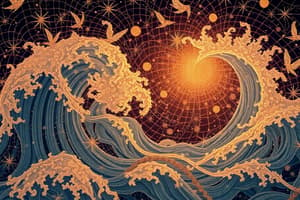Podcast
Questions and Answers
A wave is a disturbance that transfers _______ from one place to another through vibrations or oscillations.
A wave is a disturbance that transfers _______ from one place to another through vibrations or oscillations.
energy
In a longitudinal wave, the particles of the medium oscillate perpendicular to the direction of wave propagation.
In a longitudinal wave, the particles of the medium oscillate perpendicular to the direction of wave propagation.
False (B)
Which of the following is an example of a transverse wave?
Which of the following is an example of a transverse wave?
- Wave in a pipe organ
- Wave in a spring (push/pull)
- Sound wave
- Water wave (correct)
Briefly explain how waves in a ripple tank demonstrate the principle of energy transfer without matter transfer.
Briefly explain how waves in a ripple tank demonstrate the principle of energy transfer without matter transfer.
Match each type of wave with its particle motion relative to the wave's direction of travel:
Match each type of wave with its particle motion relative to the wave's direction of travel:
What is the primary factor that determines the speed of a wave in a given medium?
What is the primary factor that determines the speed of a wave in a given medium?
Increasing the frequency of a wave will always increase its speed.
Increasing the frequency of a wave will always increase its speed.
The distance between two successive crests or troughs of a wave is called its _______.
The distance between two successive crests or troughs of a wave is called its _______.
Describe how the motion of a pendulum demonstrates periodic motion, relating its back-and-forth swing to the concept of regularity.
Describe how the motion of a pendulum demonstrates periodic motion, relating its back-and-forth swing to the concept of regularity.
Which of the following best describes a wavefront?
Which of the following best describes a wavefront?
Kinetic energy spreading refers to thermal energy propagation exclusively.
Kinetic energy spreading refers to thermal energy propagation exclusively.
Transverse waves travel _______ to the direction of the dipper, while longitudinal waves travel _______ to the direction of the dipper.
Transverse waves travel _______ to the direction of the dipper, while longitudinal waves travel _______ to the direction of the dipper.
Explain what happens to the kinetic energy in a ripple tank moving from the dipper to the edges.
Explain what happens to the kinetic energy in a ripple tank moving from the dipper to the edges.
What characteristic is shared by both transverse and longitudinal waves?
What characteristic is shared by both transverse and longitudinal waves?
Associate each wave type with its example:
Associate each wave type with its example:
Flashcards
What is a Wave?
What is a Wave?
A disturbance that transfers energy from one place to another through vibrations or oscillations.
Periodic Motion
Periodic Motion
Motion that repeats at regular intervals.
Wave in a Rope
Wave in a Rope
The transfer of energy from a moving hand to a rope, creating a wave.
Source of a Wave
Source of a Wave
Signup and view all the flashcards
Wave Energy Transfer
Wave Energy Transfer
Signup and view all the flashcards
Transverse Waves in a Spring
Transverse Waves in a Spring
Signup and view all the flashcards
Longitudinal Waves in a Spring
Longitudinal Waves in a Spring
Signup and view all the flashcards
Transverse Waves
Transverse Waves
Signup and view all the flashcards
Longitudinal Waves
Longitudinal Waves
Signup and view all the flashcards
Wavefront
Wavefront
Signup and view all the flashcards
Wavelength
Wavelength
Signup and view all the flashcards
Energy Transfer in Ripple Tank
Energy Transfer in Ripple Tank
Signup and view all the flashcards
Water Particles Motion
Water Particles Motion
Signup and view all the flashcards
Study Notes
- Waves transfer energy without transferring matter.
What is a Wave?
- A wave is a disturbance that transfers energy from one place to another through vibrations or oscillations.
- Waves are made up of vibrations and oscillations.
Periodic Motion
- Periodic motion is motion repeated at regular intervals.
- The swing of a pendulum is periodic.
- A pendulum moves from point A to B, and back to A at regular intervals.
- When a pendulum moves from A to B and back to A, it completes a cycle.
Wave Motion
- A wave can be transferred from one end to another.
- Up and down motion causes a hump (wave), which moves towards the fixed end (wall).
- Movement from the hand transfers energy to the rope.
- A rope wave is a wave that travels within a rope.
- The rope wave moves from the hand to the wall.
- As a wave moves through a rope, from left to right, the rope particles (P and Q) move up and down about their original position.
- Eventually, kinetic energy is transferred from the hand to the wall.
- The source of a wave is a vibration or an oscillation.
- Waves only transfer energy from one point to another.
- Waves transfer energy without transferring matter.
Types of Waves
- Moving a spring creates motion.
- The individual spring coils move perpendicular to the direction of the wave.
- There are two types of waves, transverse and longitudinal.
Transverse Waves
- The coils move up and down, while the wave moves from left to right.
- The movement of the coils is perpendicular to the wave motion.
- Transverse waves travel perpendicular to the direction of wave.
- Examples of transverse waves are light (electromagnetic waves), water waves, and rope waves.
Longitudinal Waves
- The coils move to the left and right, while the wave moves from left to right.
- The movement of the coils is parallel to the wave motion.
- Longitudinal waves travel parallel to the direction of the wave.
- An example of longitudinal waves is sound.
Waves in a Ripple Tank
- Energy from the dipper is transferred to the water.
- Forms a water wave (a water ripple).
- The water wave moves away from the dipper.
- Kinetic energy is transferred from the dipper to the edges of the ripple tank.
- Water particles move up and down and oscillate about their original position.
- One wavefront to another wavefront equals one wavelength.
Wavefront
- A wavefront is a line on a wave that joins all adjacent points in phase.
Studying That Suits You
Use AI to generate personalized quizzes and flashcards to suit your learning preferences.




